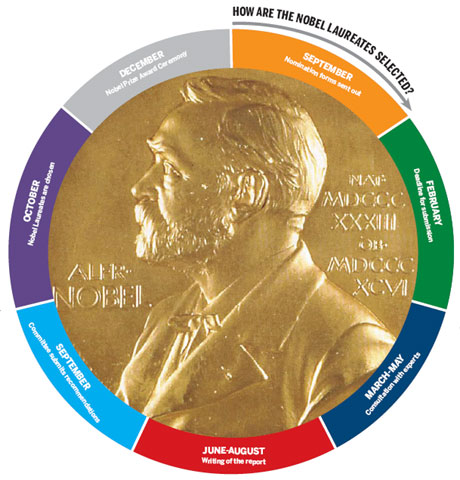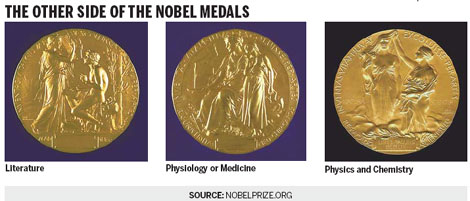Eyes on the Prize
Updated: 2011-10-02 07:02
(China Daily)
|
|||||||||

Editor's note: With five Nobel prizes set to be announced over the next few days, Thomson Reuters looks at who may be in the running for the awards.
The 2011 Thomson Reuters Citation Laureates by Nobel Prize category are
Chemistry
Allen J. Bard, Hackerman-Welch Regents Chair Professor of chemistry at University of Texas at Austin, USA
WHY: for the development and application of scanning electrochemical microscopy
Jean M. J. Frchet, Henry Rapoport Chair of Organic Chemistry, Department of Chemistry, University of California Berkeley, USA
WHY: with Donald A. Tomalia and Fritz Vgtle, for the invention and development of dendritic polymers
Donald A. Tomalia, distinguished professor at Department of Chemistry and director of the National Dendrimer and Nanotechnology Center, Central Michigan University, USA
WHY: with Jean M. J. Frchet and Fritz Vgtle, for the invention and development of dendritic polymers
Fritz Vgtle, emeritus professor, Kekul Institute for Organic Chemistry and Biochemistry, University of Bonn, Germany
WHY: with Jean M. J. Frchet and Donald A. Tomalia, for the invention and development of dendritic polymers
Martin Karplus, Theodore William Richards Emeritus Professor of Chemistry, Department of Chemistry and Chemical Biology, Harvard University, Cambridge, USA
WHY: for pioneering simulations of the molecular dynamics of biomolecules
Economic Science
Douglas W. Diamond, Merton H. Miller Distinguished Service Professor of Finance, Booth School of Business, University of Chicago, USA
WHY: for his analysis of financial intermediation and monitoring
Jerry A. Hausman, John and Jennie S. MacDonald Professor, Department of Economics, Massachusetts Institute of Technology, Cambridge, USA
WHY: with Halbert L. White, Jr, for their contributions to econometrics, specifically the Hausman specification test and the White standard errors test
Halbert L. White, Jr, Chancellor's Associates Distinguished Professor of Economics, Department of Economics, University of California San Diego, USA
WHY: with Jerry A. Hausman, for their contributions to econometrics, specifically the Hausman specification test and the White standard errors test
Anne O. Krueger, professor of International Economics, Paul H. Nitze School of Advanced International Studies, Johns Hopkins University, USA
WHY: with Gordon Tullock, for their description of rent-seeking behavior and its implications
Gordon Tullock, professor emeritus of Law and Economics, George Mason University School of Law, USA
WHY: with Anne O. Krueger, for their description of rent-seeking behavior and its implications
Physiology or Medicine
Robert L. Coffman, vice-president and chief scientific officer, Dynavax Technologies, USA
WHY: with Timothy R. Mosmann, for their discovery of two types of T lymphocytes, TH1 and TH2, and their role in regulating host immune response
Timothy R. Mosmann, professor, Department of Microbiology and Immunology, and Michael and Angela Pichichero Director in the David H. Smith Center for Vaccine Biology and Immunology, University of Rochester Medical Center, University of Rochester, USA
WHY: with Robert L. Coffman, for their discovery of two types of T lymphocytes, TH1 and TH2, and their role in regulating host immune response
Brian J. Druker, JELD-WEN Chair of Leukemia Research, and director of OHSU Knight Cancer Institute, Oregon Health & Science University, Portland, OR, USA
WHY: with Nicholas B. Lydon and Charles L. Sawyers for their development of imatinib and dasatinib, revolutionary, targeted treatments for chronic myeloid leukemia
Nicholas B. Lydon, founder, Granite Biopharma, LLC, Jackson Hole, USA; co-founder and director, AnaptysBio, San Diego, USA; and co-founder and director, Blueprint Medicines, Cambridge, USA
WHY: with Brian J. Druker and Charles L. Sawyers for their development of imatinib and dasatinib, revolutionary, targeted treatments for chronic myeloid leukemia
Charles L. Sawyers, Marie-Jose and Henry R. Kravis Chair in Human Oncology and Pathogenesis, Memorial Sloan-Kettering Cancer Center, New York, USA
WHY: with Brian J. Druker and Nicholas B. Lydon Charles L. Sawyers for their development of imatinib and dasatinib, revolutionary, targeted treatments for chronic myeloid leukemia
Joseph P. Vacanti, John Homans Professor of Surgery, Harvard Medical School; surgeon-in-chief and chief of the Department of Pediatric Surgery, Massachusetts General Hospital, USA
WHY: with Robert S. Langer, for their pioneering research in tissue engineering and regenerative medicine
Robert S. Langer, David H. Koch Institute professor, Department of Chemical Engineering, Massachusetts Institute of Technology, Cambridge.
WHY: with Joseph P. Vacanti, for their pioneering research in tissue engineering and regenerative medicine
Jacques F. A. P. Miller, emeritus professor, Walter and Eliza Hall Institute of Medical Research and the University of Melbourne, Australia
WHY: for his discovery of the function of the thymus and the identification of T cells and B cells in mammalian species
Physics
Alain Aspect, CNRS Distinguished Scientist and Head of the Atom Optics Group, Laboratoire Charles Fabry, Institut d'Optique, Palaiseau France
WHY: with John F. Clauser and Anton Zeilinger, for their tests of Bell's inequalities and research on quantum entanglement
John F. Clauser, research physicist, J.F. Clauser & Associates, Walnut Creek, USA
WHY: with Alain Aspect and Anton Zeilinger, for their tests of Bell's inequalities and research on quantum entanglement
Anton Zeilinger, full professor of Experimental Physics, University of Vienna, and scientific director, Institute of Quantum Optics and Quantum Information, Austrian Academy of Sciences, Vienna Austria
WHY: with Alain Aspect and John F. Clauser, for their tests of Bell's inequalities and research on quantum entanglement
Sajeev John, professor of Physics and Canada Research Chair, Department of Physics, University of Toronto, Canada
WHY: with Eli Yablonovitch, for their invention and development of photonic band gap materials
Eli Yablonovitch, professor and James and Katherine Lau Chair in Engineering, Department of Electrical Engineering and Computer Sciences, University of California Berkeley, USA
WHY: with Sajeev John, for their invention and development of photonic band gap materials
Hideo Ohno, professor of the Laboratory for Nanoelectronics and Spintronics, Research Institute of Electrical Communication, and director of the Center for Spintronics Integrated Systems, Tohoku University, Japan
WHY: for contributions to ferromagnetism in diluted magnetic semiconductors
China Daily

(China Daily 10/02/2011 page7)